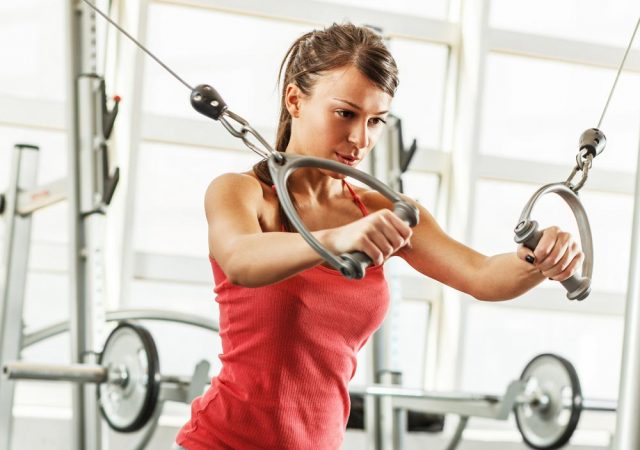
You may have heard people claim that weight training reduces the breast size of “the girls.” In fact, some women avoid strength training for fear that they’ll lose their feminine curves. That’s shortsighted! We know consistent strength training DOES change the shape of our bodies, but usually for the better. Women who weight train often get stronger, leaner and tighter. With consistent training, you’ll notice more muscle definition as well. But, what about breast size? Do you have to worry about losing too much breast tissue if you train with heavy weights? Here’s what you should know.
The Composition of Healthy Breasts
Breasts are a mix of glandular tissue, fat, and milk ducts that lymph nodes, nerves, and blood vessels pass through. Each breast is supported by strong, thick, connective tissue and ligaments that help support and hold everything in place. Glandular tissue is important if you become pregnant and decide to breastfeed, as this is the portion of your breast tissue that produces milk. It’s also the hormone-sensitive portion of your breast tissue. Glandular tissue of the breast is organized into sections called lobes and further sub-divided into smaller structures called lobules. The lobules produce milk. Once produced, the milk travels through passageways called ducts that eventually connect with the nipples.
Then, there’s the fatty component of your breast. Just as other parts of your body have fat tissue, so do your breasts. When you have a higher percentage of body fat, your breasts also contain more fatty tissue, but you’ll lose some of this fat if you get leaner. The size of your breasts is determined by how much glandular tissue your breast have as well as how much fat. An increase in either boosts breast size.
The amount of glandular tissue you have is determined partially by genetics but is influenced by hormones, like estrogen and progesterone. That’s why your breasts change size throughout your menstrual cycle as levels of estrogen and progesterone rise and fall. After menopause, as your estrogen levels decline, you might notice that your breasts look a bit smaller. Also, if you use oral contraceptives or take hormone replacement therapy, your breasts will appear fuller due to the impact the estrogen in the pill has on glandular tissue.
As mentioned, before menopause where you are in your menstrual cycle can impact the size of your breasts. Around the time of ovulation, estrogen tends to be high and blood flow to breast tissue is at its peak, so your breasts tend to look fuller. Also, just before a menstrual period, many women retain water and breast tissue becomes swollen and, sometimes, tender.
However, we know fatty tissue is a factor in how large your breasts are. If you lose body fat, your breast size will go down as well as you no longer have as much fat stored in your breasts. People with lower body fat percentages tend to have smaller breasts unless they genetically have a large amount of glandular tissue.
The Impact of Weight Training on Breast Size
So, how does weight training affect breast size? When you weight train aggressively, you build strength and muscle size, but you may also lose body fat. Not surprisingly, as you lose fat, your breasts become smaller. Women who compete in fitness competitions often get down to a very low body fat, at least temporarily and lose a significant amount of breast tissue.
So, it’s not that weight training directly causes breast tissue to shrink, it’s the loss of body fat, including fat within the breast tissue that causes the breasts to look smaller in size. In fact, you may notice some shrinkage in the size of your breasts if you lose weight for any reason. With some types of exercise, especially prolonged, endurance exercise, you might experience a loss of glandular breast tissue as well. That’s because excessive endurance exercise, such as long-distance running, can cause a drop-in estrogen and that reduces the glandular component of breast tissue.
What about the idea that doing chest exercises can boost the size of your breasts? If you build up your pectoral muscles through upper-body training, it can make your breasts look at bit “perkier,” however it won’t increase the size of the breast tissue itself. Remember, weight training only impacts the muscle underneath the breasts, not the breasts themselves. However, hypertrophying your chest muscles can make your breasts look a bit more prominent.
Can Weight Training Improve the Appearance of Droopy Breasts?
Once concern that women have, especially after menopause, is breast sagging. Breasts are held up by bands of connective tissue called Cooper’s ligaments. Actually, these “ligaments” aren’t truly ligaments, like the ones that connect bone to bone. In fact, they’re quite a bit weaker and tend to stretch over time. As they stretch, your breasts drop along with them. Weight training won’t restore the stretched ligaments, but developing your pecs may give the illusion of firmer breasts. With the positive changes that weight training has, you’ll likely discover you like the overall shape of your body, regardless of the size of your breasts.
The Bottom Line
If you weight train consistently, you may lose some breast size, but it’s mainly due to loss of body fat. You would experience the same reduction if you lost weight without weight training, although you probably wouldn’t like your physique as much. On the plus side, weight training can actually make your breasts look a bit perkier, regardless of their size – and when you combine it with the other body-shaping benefits that strength training offers, it’s easy to see why more curve-conscious women are doing it – and loving the results!
References:
BMC Med Genet. 2012; 13: 53.
Cleveland Clinic. “Breast Anatomy”
Related Articles by Cathe:
This content was originally published here.









